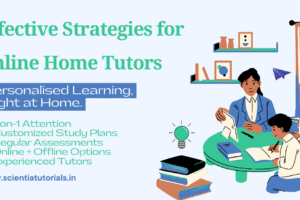Empowering Success: Teaching Tips for Home Tutors on Helping Students Set and Achieve Academic Goals at Home
Introduction
One of the key responsibilities of home tutors is not just to teach subject matter, but to guide students toward long-term academic success. A critical part of this journey is helping students set and achieve their academic goals. Academic goals provide students with direction, motivation, and a sense of accomplishment as they progress. For home tutors, this means going beyond daily lessons to foster a goal-setting mindset that encourages continuous growth and improvement.
This article will explore effective strategies for helping students set and achieve their academic goals while studying at home. From identifying goals to maintaining motivation, these tips will guide home tutors in empowering their students to reach their full academic potential.
1. The Importance of Academic Goal-Setting
Why Setting Academic Goals Matters
Setting academic goals gives students a roadmap for their educational journey. It allows them to understand their strengths and weaknesses, gives them a clear path to success, and motivates them to stay on track. Without clear goals, students may struggle to find direction and remain focused, leading to frustration and stagnation in their learning.
Benefits of Academic Goal-Setting:
- Provides Direction: Goals help students focus their efforts on specific outcomes, preventing them from being overwhelmed by broad subjects.
- Increases Motivation: When students set their own goals, they feel a sense of ownership and are more motivated to achieve them.
- Builds Accountability: Regular goal-setting and tracking hold students accountable for their learning progress.
- Encourages Independence: By setting and achieving goals, students develop self-discipline and become more independent learners.
- Boosts Confidence: Achieving academic goals provides students with a sense of accomplishment, which builds confidence in their abilities.
For home tutors, teaching students how to set and achieve goals is an essential step in developing lifelong learning skills.
2. Assessing Individual Learning Needs and Strengths
Tailoring Goals Based on Student Abilities
Before helping students set academic goals, home tutors need to assess their individual learning needs, strengths, and weaknesses. Every student learns differently, and their goals should reflect their unique abilities and challenges.
Steps to Assess Student Abilities:
- Evaluate Current Performance: Begin by reviewing the student’s current academic performance. Identify subjects where they excel and areas where they struggle. This can be done through informal assessments, quizzes, and conversations about their learning experiences.
- Consider Learning Styles: Recognize that students have different learning styles—some may be visual learners, while others prefer hands-on experiences. Tailor goals to their preferred way of learning to maximize their potential.
- Identify Personal Interests: A student’s interests and passions can be leveraged to make goal-setting more engaging. For example, if a student is passionate about space, use astronomy-related goals to enhance their understanding of science and math.
By understanding each student’s learning profile, home tutors can help them set realistic and attainable goals that align with their strengths and interests.
3. Collaborative Goal Setting
Involving Students in the Goal-Setting Process
One of the most effective ways to ensure student commitment to their goals is to involve them in the goal-setting process. When students take an active role in defining their own goals, they are more likely to be motivated and engaged in achieving them.
Strategies for Collaborative Goal Setting:
- Ask Open-Ended Questions: Begin by asking students about their long-term academic goals and aspirations. Encourage them to think about where they want to improve and what subjects they enjoy the most.
- Set SMART Goals: Teach students how to set SMART (Specific, Measurable, Achievable, Relevant, Time-bound) goals. For example, rather than setting a vague goal like “improve in math,” a SMART goal would be “increase my math grade by 10% over the next three months by practicing for 30 minutes each day.”
- Break Down Large Goals: Help students break larger goals into smaller, more manageable steps. For example, if a student wants to improve their writing skills, break it down into tasks like improving vocabulary, mastering grammar rules, and writing daily essays.
This collaborative approach ensures that students feel invested in their goals and understand how to achieve them step by step.
4. Creating a Structured Learning Plan
Building a Path to Success
Once goals have been set, the next step is to create a structured learning plan that outlines the actions needed to achieve those goals. A clear, well-organized plan will help students stay focused, manage their time effectively, and track their progress.
Steps for Creating a Structured Learning Plan:
- Schedule Regular Study Sessions: Consistency is key to achieving academic goals. Help students create a study schedule that includes regular study sessions for each subject. Ensure that the schedule is balanced, allowing time for rest, hobbies, and other interests.
- Prioritize Tasks: Encourage students to prioritize their tasks based on deadlines and difficulty. Teach them how to manage their time by focusing on the most important tasks first. This helps avoid last-minute cramming and reduces stress.
- Include Breaks and Rewards: To keep students motivated, incorporate breaks and small rewards into the learning plan. For example, after completing a challenging task, allow a short break or offer a reward such as extra free time or a favorite snack.
- Track Progress Regularly: Set up regular check-ins to review the student’s progress toward their goals. This can be done weekly or bi-weekly, depending on the student’s needs. Use these check-ins to adjust the learning plan as needed and provide feedback on their performance.
A structured learning plan gives students a clear pathway to success and helps them stay organized as they work toward their academic goals.
5. Motivating Students and Overcoming Challenges
Keeping Students Motivated Throughout the Process
Achieving academic goals is a long-term process, and maintaining motivation can be difficult, especially when students encounter challenges or setbacks. Home tutors play a critical role in keeping students motivated and helping them overcome obstacles.
Strategies for Maintaining Motivation:
- Celebrate Small Wins: Recognize and celebrate even the smallest achievements along the way. Positive reinforcement boosts confidence and keeps students motivated to continue working hard.
- Encourage a Growth Mindset: Teach students the value of a growth mindset—the belief that effort and persistence lead to improvement. Help them see challenges as opportunities for growth rather than setbacks.
- Use Real-Life Examples: Show students how their academic goals are relevant to their future success. For example, explain how mastering certain math skills could be important for a future career in engineering or science.
- Provide Emotional Support: Academic challenges can sometimes lead to frustration or a loss of confidence. Offer emotional support by listening to students’ concerns and providing encouragement when they face difficulties.
Helping students maintain motivation and resilience is essential in ensuring that they stay on track and continue making progress toward their goals.
6. Reviewing and Adjusting Goals
Adapting Goals Based on Progress and Challenges
As students work toward their academic goals, it’s important to periodically review and adjust those goals based on their progress. Academic goals should not be set in stone—flexibility is key to adapting to new challenges, changing interests, or unforeseen obstacles.
Steps for Reviewing and Adjusting Goals:
- Conduct Regular Check-Ins: Regularly review the student’s progress to see if they are on track to meet their goals. This can be done through assessments, discussions, or self-reflection exercises.
- Identify Obstacles: If a student is struggling to meet a goal, identify the obstacles in their way. Is the goal too ambitious? Are there external factors affecting their progress, such as a busy schedule or personal challenges? Once obstacles are identified, adjust the goal or the learning plan accordingly.
- Set New Goals: Once a goal is achieved, celebrate the success and encourage the student to set a new goal. Continuous goal-setting keeps students engaged in their learning and helps them build a mindset of continuous improvement.
Regularly reviewing and adjusting goals ensures that students remain focused and continue to progress, even in the face of challenges.
7. Fostering Independence and Responsibility
Encouraging Self-Directed Learning
One of the ultimate goals of home tutoring is to help students become independent, self-directed learners who can set and achieve goals on their own. By teaching students how to set realistic goals, manage their time, and stay motivated, tutors can empower students to take control of their own education.
How to Foster Independence in Students:
- Teach Goal-Setting Skills: Encourage students to set their own academic goals, even after tutoring sessions are over. Provide them with the tools they need to assess their progress and adjust their learning plans as needed.
- Promote Self-Reflection: Teach students how to reflect on their performance and identify areas for improvement. This can be done through regular self-assessment or journaling exercises.
- Encourage Accountability: Hold students accountable for their progress by giving them ownership of their learning. This can include setting deadlines for their own assignments or tracking their progress toward goals independently.
By fostering independence and responsibility, home tutors can help students develop lifelong skills that will serve them well beyond their academic years.
Conclusion
Helping students set and achieve academic goals is one of the most impactful roles a home tutor can play. Through thoughtful goal-setting, collaborative planning, and ongoing support, tutors can empower their students to take charge of their learning, overcome challenges, and achieve success. By teaching students the value of persistence, time management, and self-reflection, home tutors lay the foundation for academic and personal growth that extends far beyond the classroom.
With the right approach, home tutors can guide students toward not only achieving their current academic goals but also developing the skills they need to become independent, motivated, and lifelong learners.



